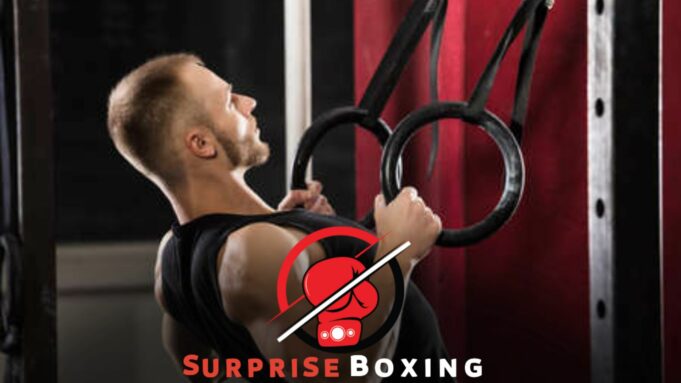Yes, gymnastics rings are suitable for boxing as they improve upper body strength and stability, which are crucial for boxing technique and power. They also enhance core strength and coordination, helping boxers balance and control during punches.
Gymnastics rings have long been recognized as a valuable tool for building strength and conditioning for gymnasts and athletes in various disciplines. In recent years, boxing trainers and athletes have started incorporating gymnastics rings into their training routines.
This is because gymnastics rings offer unique benefits that can enhance a boxer’s performance. From improving upper body strength and stability to enhancing core strength and coordination, gymnastics rings give fighters various advantages to help them excel in their sport. We will explore why gymnastics rings are a valuable training tool for boxers and how they can improve their performance.
Advantages of Integrating Gymnastics Rings Into Boxing Workouts

Integrating gymnastics rings into boxing workouts offers several advantages. These versatile tools improve upper body strength, stability, and coordination, enhancing boxing performance and technique.
Gymnastics rings are not only for gymnasts but also offer many advantages when incorporated into boxing workouts. These versatile and challenging apparatus can enhance boxing training by improving strength, stability, coordination, and overall performance. This section will explore the advantages of integrating gymnastics rings into boxing workouts.
Increased Upper Body Strength
- Gymnastics rings provide an excellent opportunity to develop upper body strength, especially in the arms, shoulders, and back.
- The instability of the rings engages more muscle groups than traditional weightlifting or bodyweight exercises, resulting in well-rounded and functional strength.
Enhanced Core Stability
- Boxing requires a strong and stable core for generating power and maintaining balance during movements.
- The instability of gymnastics rings forces your core muscles to work harder to maintain control and stability, leading to increased core strength and improved boxing techniques.
Improved Shoulder Stability
- Boxing often places a significant demand on the shoulders, making shoulder stability crucial for injury prevention and optimal performance.
- Gymnastics ring exercises such as ring dips and ring push-ups help strengthen the muscles around the shoulder joint, promoting shoulder stability and reducing the risk of injuries.
Enhanced Proprioception and Body Awareness
- Proprioception, the awareness of one’s body position in space, is essential in boxing for precise movements and maintaining balance.
- Training with rings challenges your proprioceptive abilities as the calls require constant adjustments and control, leading to improved body awareness and coordination.
Functional Movement Patterns
- Gymnastics ring exercises mimic functional movements that closely resemble the actions used in boxing, such as pulling, pushing, and rotating.
- Utilizing these functional movement patterns can improve your boxing skills by developing strength and control in the movements that directly transfer to the sport.
Versatile and Portable Training Tool
- Gymnastics rings are easily adjustable and portable, allowing you to perform exercises anywhere, whether in a boxing gym, outdoor training space, or at home.
- You can integrate gymnastics rings into your boxing workouts to add variety and challenge, making your training sessions more engaging and effective.
Increased Flexibility and Mobility
- Boxing requires flexibility and mobility for fluid movements and optimal performance.
- Strengthening exercises using gymnastics rings, such as Skin the Cat and German Hang, can improve your flexibility and mobility, leading to more efficient punches, footwork, and defensive maneuvers in the ring.
Improved Bodyweight Control
- Gymnastics ring training teaches you how to control your body weight effectively, as the rings require constant stabilization and control throughout the movements.
- This bodyweight control translates directly into boxing, allowing you to maneuver with agility, maintain balance, and generate power efficiently with your body.
Mental Focus and Discipline
- Working with gymnastics rings demands concentration, mental focus, and discipline to perform movements with control and precision.
- These mental attributes cultivated during ring training can positively impact your boxing performance by enhancing your ability to stay focused, make quick decisions, and execute strategies effectively.
Injury Prevention
- The involvement of multiple muscle groups during gymnastics ring exercises helps to develop balanced strength and prevent muscle imbalances.
- A balanced musculature is crucial for injury prevention in boxing, where imbalances can lead to overuse injuries or decreased performance.
Integrating gymnastics rings into your boxing workouts can be an incredible way to take your training to the next level. It provides a new dimension to your workout routine and enables you to develop essential physical attributes, improve technique, and enhance overall performance.
So why not try gymnastics rings and experience the countless benefits they can bring to your boxing journey?
Specific Exercises and Techniques To Enhance Your Boxing Training With Gymnastics Rings
Enhance your boxing training with specific exercises and techniques using gymnastics rings. These versatile tools can improve your strength, balance, and coordination, ultimately enhancing your performance in the round. Discover the benefits of incorporating gymnastics rings into your boxing workout routine.
Combining gymnastics rings and boxing training may not seem like an obvious pairing. Still, it can benefit boxers looking to improve their skills and overall performance. Gymnastics rings offer a unique training approach that can enhance strength, stability, and coordination, which are essential for boxing.
Here are some specific exercises and techniques to incorporate gymnastics rings into your boxing training routine:
Upper Body Strength and Stability
- Ring dips: Perform dips on the rings to strengthen your triceps, chest, and shoulders. This exercise also helps improve stability and control in the upper body, which is crucial for generating power in boxing punches.
- Ring push-ups: By doing push-ups on the rings, you engage more muscles in the shoulders, chest, and core than traditional push-ups. This exercise helps develop upper body strength and stability for powerful punches.
- Ring rows: Performing rows on the rings strengthens your back, shoulders, and arm muscles. It also improves posture and balance, which are essential in boxing for maintaining proper technique and guard.
Core and Balance
- Ring plank hold: Get into a position with your feet suspended in the rings. This exercise activates your core muscles, including the abs and lower back, to develop stability and improve balance. A strong core is crucial for generating power and maintaining a solid stance in boxing.
- Ring l-sit: Sit on the rings with your legs extended straight. This exercise targets the abs, hip flexors, and shoulders. L-sits help develop core strength and improve balance, which is beneficial for generating power and stability in boxing movements.
Mobility and Flexibility
- Ring muscle-ups: Muscle-ups on the rings involve pulling and pushing movements, requiring strength, coordination, and flexibility. This exercise improves upper body mobility and enhances overall body control, which can translate to improved boxing performance.
- Ring swings: Swing on the rings by using your body’s momentum and engaging your core muscles. This exercise helps improve shoulder mobility, flexibility, and coordination, all essential for fluid and powerful boxing movements.
Incorporating these gymnastics ring exercises and techniques into your boxing training can enhance your strength, stability, balance, and mobility, ultimately improving your overall performance. Remember to gradually progress and ensure proper form and technique while performing these exercises to maximize their benefits.
So why not try gymnastics rings and take your boxing training to the next level?
Considerations and Precautions: Safeguarding Your Training With Gymnastics Rings
Discover the benefits of incorporating gymnastics rings into your boxing training regimen. Enhance your strength, stability, and coordination while minimizing the risk of injury with this versatile and challenging workout tool. Safeguard your training and elevate your boxing performance with gymnastics rings.
Gymnastics rings can be a valuable training tool for boxers looking to enhance their strength, stability, and overall performance in the ring. However, before incorporating gymnastics rings into your boxing training routine, it is essential to consider a few factors and take the necessary precautions to ensure a safe and effective workout.
In this section, we will explore these considerations and precautions in detail.
Benefits of Gymnastics Rings for Boxing Training
- Improved core strength: Incorporating gymnastics rings into your training can help develop strong and stable core muscles, essential for generating power and maintaining balance in boxing.
- Enhanced upper body strength: Ring exercises such as pull-ups, dips, and muscle-ups target the muscles in your upper body, including the arms, shoulders, chest, and back. Strengthening these muscles can improve punching power and endurance in the ring.
- Increased stability and balance: Ring exercises require high strength and balance, as they involve balancing your body weight on suspended rings. This can translate to improved footwork and balance during boxing movements.
- Versatility and variety: Gymnastics rings offer various exercise options targeting different muscle groups and movement patterns. This variety can prevent training plateaus and keep your workouts engaging and challenging.
Precautions To Take When Using Gymnastics Rings for Boxing
- Proper technique and form: Learning the correct design and condition for all ring exercises is essential to avoid injury and maximize the benefits. Seek guidance from a qualified coach or trainer to execute the movements correctly.
- Gradual progression: When incorporating gymnastics rings into your training, start with the basics and gradually progress to more advanced exercises. This allows your body to adapt to the demands of ring training and reduces the risk of overuse injuries.
- Correct ring height and stability: Ensure the rings are hung appropriately and secured adequately before starting your workout. Adjust the size based on your skill level and exercise difficulty to maintain optimal safety and stability.
- Warm-up and cool-down: Like any other workout, warming up and cooling down are crucial when using gymnastics rings. Prioritize dynamic stretches and exercises that target the relevant muscle groups to prepare your body for the demands of ring training and aid in recovery post-workout.
- Listen to your body: Avoid discomfort or pain during your ring training sessions. It is essential to listen to your body’s signals and modify or stop exercises that cause undue strain or discomfort to prevent injuries.
- Use a spotter: If you are new to ring training or attempting advanced exercises, consider having a spotter present to provide assistance and ensure your safety.
- Maintain good grip strength: Developing and maintaining a solid grip is crucial for ring training. Incorporate grip-specific exercises into your routine to improve grip strength and stability on the rings.
By considering these precautions and effectively incorporating gymnastics rings into your boxing training routine, you can reap the benefits of improved strength, stability, and overall performance. However, always prioritize safety and consult a professional with any concerns or questions.
Drawbacks and Limitations of Integrating Gymnastics Rings Into Boxing Training
Integrating gymnastics rings into boxing training can have drawbacks and limitations. While the calls can improve upper body strength and coordination, they may not directly translate into boxing-specific skills and techniques. Additionally, the learning curve for mastering ring exercises can be steep and time-consuming for boxers focused on their primary training goals.
Gymnastics rings have gained popularity among athletes for their versatility and functional training benefits. While they can be a valuable addition to a boxing training routine, knowing the potential drawbacks and limitations of incorporating gymnastics rings into boxing training is essential.
Here, we’ll explore some of these limitations:
Risk of Injury
- Rings training requires a high level of strength and stability. Improper form or overexertion can lead to injuries, particularly in the shoulders, wrists, and elbows. Beginners may find controlling their movements on the rings challenging, increasing the risk of accidents.
Complex Skill Set
- Mastering gymnastics ring exercises demands time, patience, and dedication. Boxers new to ring training may struggle to grasp the proper techniques and maintain the required body position. Investing ample time in learning and gradually progressing to more advanced movements is essential.
Limited Upper Body Strength Focus
- While gymnastics rings offer excellent upper-body strength gains, they primarily target pulling movements. Though boxing requires a solid upper body, it also heavily relies on pushing activities, which are less emphasized in in-ring training. Boxers must incorporate additional exercises that address these pushing movements to maintain a well-rounded strength base.
Space and Equipment Requirements
- Gymnastics ring training requires a dedicated space with sturdy support beams or a secure outdoor area. This limitation may restrict individuals who don’t have access to suitable training facilities or prefer training in limited spaces like home gyms.
Expensive Investment
- Acquiring a set of high-quality gymnastics rings can be costly. For some boxers on a tight budget, this financial investment may not be feasible or justifiable compared to other training equipment available at a lower cost.
Time Commitment
- Incorporating gymnastics rings into boxing training often requires an additional time commitment. Learning new movements, practicing proper technique, and building enough strength to perform advanced exercises can be time-consuming. Boxers must evaluate whether they can allocate sufficient time to ring training without neglecting other essential aspects of their training regimen.
Overall Integration
- While gymnastics rings can enhance certain aspects of boxing training, such as upper body strength and stability, they should be considered a complementary tool rather than a primary training method. Boxers must balance ring training and other boxing-specific workouts to ensure proficiency in the necessary skills and techniques.
By considering these drawbacks and limitations, boxers can make informed decisions about integrating gymnastics rings into their training routines. Understanding the potential challenges associated with ring training allows fighters to adapt and maximize the benefits while minimizing the risks.
Expert Insights: Advantages of Gymnastics Ring Training From Boxing and Fitness Professionals
Gymnastics ring training provides numerous advantages for boxing enthusiasts, allowing them to enhance their upper body strength, stability, and coordination. Experts in boxing and fitness highly recommend incorporating gymnastics rings into training routines for improved performance in the round.
Gymnastics rings are not only a staple in gymnastics but have also gained popularity among boxing and fitness professionals. Their versatile and demanding nature offers numerous advantages for those looking to enhance their boxing performance and overall fitness level.
Let’s dive into the expert insights on the benefits of gymnastics ring training:
Increased Upper Body Strength and Stability
- Developing upper body strength is crucial for boxers, as it allows for powerful punches and better control in the ring.
- Gymnastics ring training engages multiple muscle groups, including arms, shoulders, back, and core, improving upper body strength.
- Boxers can strengthen their muscles and enhance stability by performing exercises such as ring dips, pull-ups, and push-ups, leading to more effective punches.
Enhanced Core Strength and Balance
- Core strength is essential for maintaining balance and stability and generating force in boxing.
- Gymnastics ring exercises, like ring holds and ring roll-outs, challenge the core muscles to stabilize the body while performing various movements.
- By incorporating ring training into their routines, boxers can strengthen their core, improve balance, and enhance their overall boxing performance.
Improved Grip Strength
- A firm grip is advantageous in grappling and clinching and also crucial for throwing potent punches.
- Gymnastics rings require a firm grip to maintain stability during exercises, increasing grip strength.
- The constant tension and control required during ring training can significantly benefit a boxer’s hand and forearm muscles, improving their punching power.
Enhanced Flexibility and Range of Motion
- Flexibility and mobility are vital for boxers to move fluidly and avoid straining their muscles.
- Gymnastics rings allow for a wide range of dynamic movements, promoting flexibility and enhancing the boxers’ range of motion.
- Exercises like skin the cats and front lever progressions performed on rings can increase flexibility and mobility, helping boxers avoid injuries and move efficiently in the round.
Functional Training and Muscular Balance
- Gymnastics ring training emphasizes functional movements, replicating real-life scenarios, and enhancing overall athleticism.
- By incorporating gymnastics ring exercises into their training routines, boxers can work on developing well-rounded strength and muscular balance.
- This type of training helps ensure that all muscle groups are equally strengthened, reducing the risk of muscle imbalances and potential injuries.
Mental Focus and Coordination
- Boxing requires acute mental focus and exceptional coordination between various movements.
- Gymnastics ring training challenges individuals to maintain body control, stability, and concentration during exercises.
- By consistently practicing on gymnastics rings, boxers can improve their mental focus, enhance coordination, and effectively transfer those skills into the boxing ring.
Improved Body Control and Proprioception
- Body control and proprioception, the awareness of one’s body in space, are crucial in boxing to execute precise movements.
- Gymnastics ring training requires individuals to maintain control while performing complex exercises, enhancing body awareness and control.
- By incorporating ring training into their routine, boxers can improve their body control, leading to more precise movements and better defensive techniques.
Versatile Training Options
- Gymnastics rings offer a wide range of exercise options that can be tailored to suit individual needs and goals.
- Boxers can incorporate ring exercises into their training routines, targeting specific muscle groups and boxing-related movements.
- From dips and pull-ups to muscle-ups and leverage exercises, gymnastics rings can be utilized for a versatile and challenging workout regimen.
Engaging Core and Full-Body Workout
- Gymnastics ring training engages the upper body and the core and lower body muscles.
- Exercises like l-sits, tuck holds, and inverted rows require a strong engagement of the core and lower body muscles.
- By incorporating ring training into their workouts, boxers can enjoy a comprehensive full-body exercise that targets multiple muscle groups simultaneously.
Injury Prevention and Rehabilitation
- Gymnastics ring training can contribute to injury prevention and rehabilitation for boxers.
- By incorporating ring exercises into their routines, boxers can strengthen their muscles, improve joint stability, and enhance overall functional strength, reducing the risk of injuries.
- Additionally, ring training can be part of a rehabilitation program, helping boxers recover from specific injuries and regain strength and mobility.
Gymnastics ring training offers a plethora of advantages for boxing and fitness professionals. From increased upper body strength and stability to enhanced core strength and balance, incorporating gymnastics rings into training routines can significantly benefit boxers, leading to improved performance in the round and overall fitness level.
Versatility
- Rings allow for a wide range of exercises that target different muscle groups.
- They can be used for upper-body strength training, core strength development, and even lower-body exercises.
- By using gymnastics rings, boxers can work on their overall athletic abilities, directly translating to improved performance in the round.
Upper Body Strength
- Gymnastics rings engage multiple muscle groups simultaneously, leading to greater upper-body strength.
- The unstable nature of the rings forces boxers to engage their stabilizer muscles, promoting a more well-rounded and functional strength.
- Ring exercises like pull-ups, dips, and push-ups can significantly enhance a boxer’s punching power and upper-body strength.
Core Stability
- Rings challenge a boxer’s core stability, crucial for generating power and maintaining balance in the ring.
- Exercises such as ring planks, l-sits, and ring pikes help improve core strength and stability, enabling boxers to move more efficiently and effectively during their bouts.
Grip Strength
- Holding onto the rings requires a firm grip, which is essential for maintaining control during boxing movements.
- Ring exercises like hanging leg raises and ring rows can improve grip strength, enabling boxers to deliver powerful punches while maintaining a secure grip on their opponents.
Injury Prevention
- The instability of gymnastics rings helps develop joint stability, reducing the risk of injuries.
- Boxers who incorporate ring exercises into their training routine may experience improved shoulder stability and overall joint health, reducing the risk of common boxing-related injuries.
Overall Athletic Performance
- Gymnastics rings offer a unique training experience that complements traditional boxing exercises.
- By incorporating ring training into their routine, boxers can enhance their overall strength, stability, balance, and agility, which are all vital for success in the ring.
Gymnastics rings are an excellent training tool for boxers. Their versatility, ability to improve upper body strength, core stability, grip strength, and injury prevention make them a valuable asset to any boxer’s training regimen. By incorporating ring exercises into their routine, fighters can enhance their overall athletic performance, giving them a competitive edge in the ring.
So, if you’re a boxer looking to take your training to the next level, consider incorporating gymnastics rings into your workout routine.

Frequently Asked Questions of Are Gymnastics Rings Good for Boxing
What Are Gymnastics Rings Good for?
Gymnastics rings are versatile and beneficial for full-body workouts at home or in the gym. Engaging multiple muscle groups improves strength, stability, and flexibility. Rings enhance upper body strength by targeting the arms, shoulders, back, and chest. They also challenge the core muscles through stability and balance exercises.
Furthermore, gymnastics rings to aid in developing grip strength and improving coordination, making them suitable for athletes of all levels. Rings allow for progressive training from basic exercises like pull-ups and dips to advanced moves like muscle-ups and front levers. They are portable and adjustable, suitable for various skill levels and body types.
Whether you are a gymnast, a cross fitter, or someone looking for a full-body workout, gymnastics rings are an effective tool for building strength, muscle, and overall fitness.
Do Gymnastics Rings Build Strength?
Yes, gymnastics rings build strength as they engage multiple muscle groups and require stability. The rings challenge your upper-body muscles, including arms, shoulders, chest, and back. The instability of the rings activates smaller stabilizer muscles, improving overall strength and stability.
Consistent ring training can enhance flexibility, core strength, and grip strength. They allow various exercises such as push-ups, dips, pull-ups, rows, and muscle-ups. These exercises improve functional strength and promote muscle growth. Adding gymnastics rings to your workout routine can help you develop lean muscle mass, increase power, and enhance body control.
Regular practice on the rings will lead to noticeable improvements in overall strength and athletic performance.
Can You Get Jacked With Gymnastic Rings?
Yes, you can get jacked with gymnastic rings. Gymnastic rings are versatile equipment that can help you build strength, muscle, and definition. Using your body weight as resistance, the rings engage multiple muscles simultaneously, resulting in a highly effective workout.
Ring exercises such as pull-ups, dips, push-ups, and rows target your arms, shoulders, chest, back, and core muscles, providing a comprehensive full-body workout. The instability of the rings also engages your stabilizer muscles, improving balance and coordination. Incorporating gymnastic rings into your fitness routine can increase muscle mass, improve strength, and a more sculpted physique.
So, if you are looking to get jacked, gymnastic rings can be a valuable addition to your training regimen.
Do Gymnastic Rings Build Abs?
Gymnastic rings are effective for building abs. The calls challenge your core muscles, which include the abs. The instability of the rings forces your abs to work harder to maintain balance and stability during exercises like ring dips, ring push-ups, and ring rows.
These exercises engage the abs and the entire core, resulting in more robust and defined abdominal muscles. You can strengthen and sculpt your abs over time by consistently incorporating gymnastic ring exercises into your workout routine. So, if you want to develop your abdominal muscles, incorporating gymnastic rings into your training can be highly beneficial.
Conclusion
Incorporating gymnastics rings into boxing training can offer a range of benefits for athletes. The coils’ versatility allows for various exercises that improve upper body strength, stability, and coordination, which are crucial for boxing performance.
By utilizing the rings, fighters can target specific muscle groups, enhance balance and flexibility, and develop explosive power. Additionally, the instability of the rings engages the core muscles, promoting greater overall body control. Whether it’s performing ring dips, pull-ups, or body rows, the rounds offer a challenging and effective way to enhance boxing skills.
Furthermore, gymnastics rings can help prevent injury by promoting proper body alignment and encouraging balanced muscle development. For boxers seeking to take their training to the next level, incorporating gymnastics rings into their routine can be a valuable addition that yields impressive results in the round.














